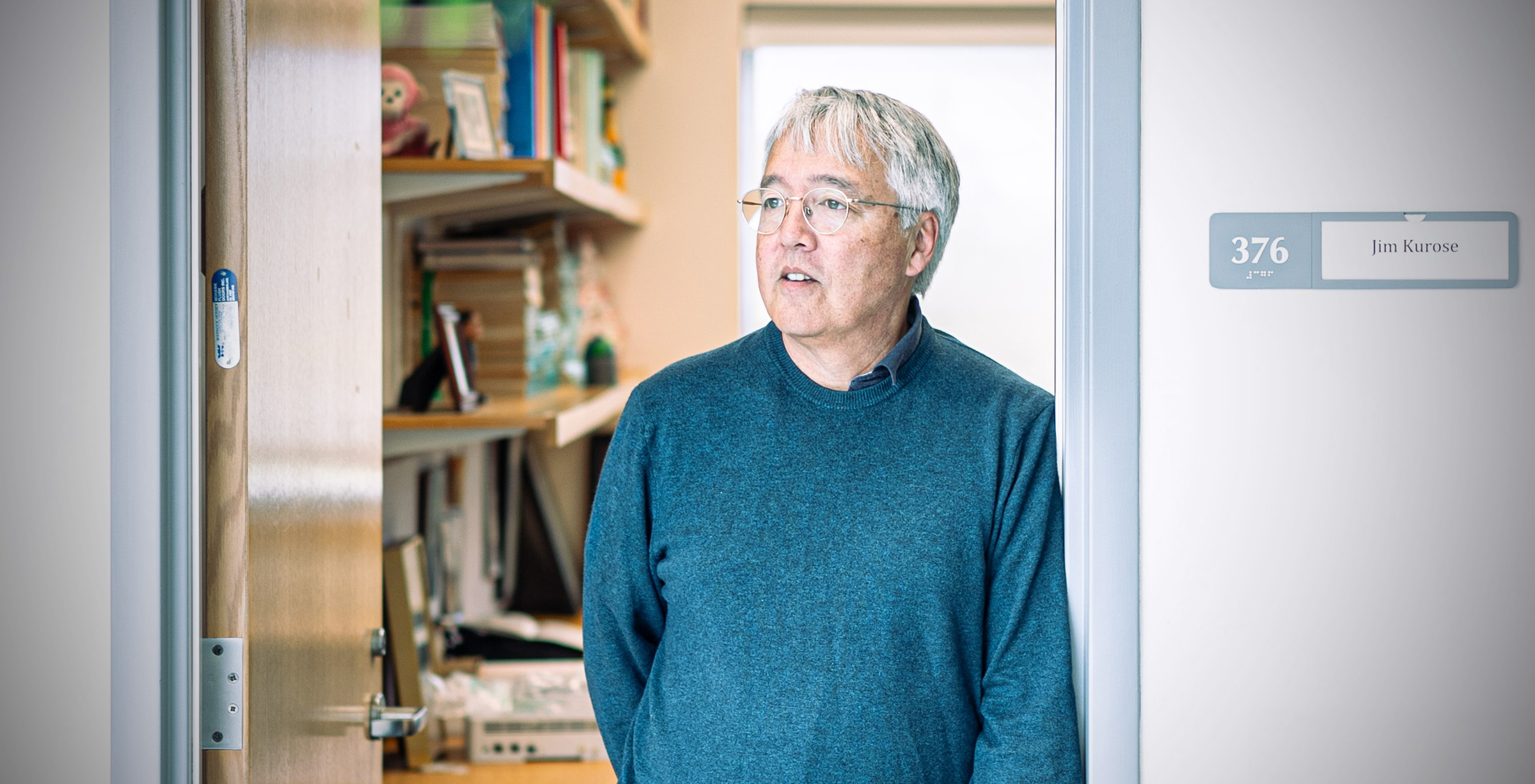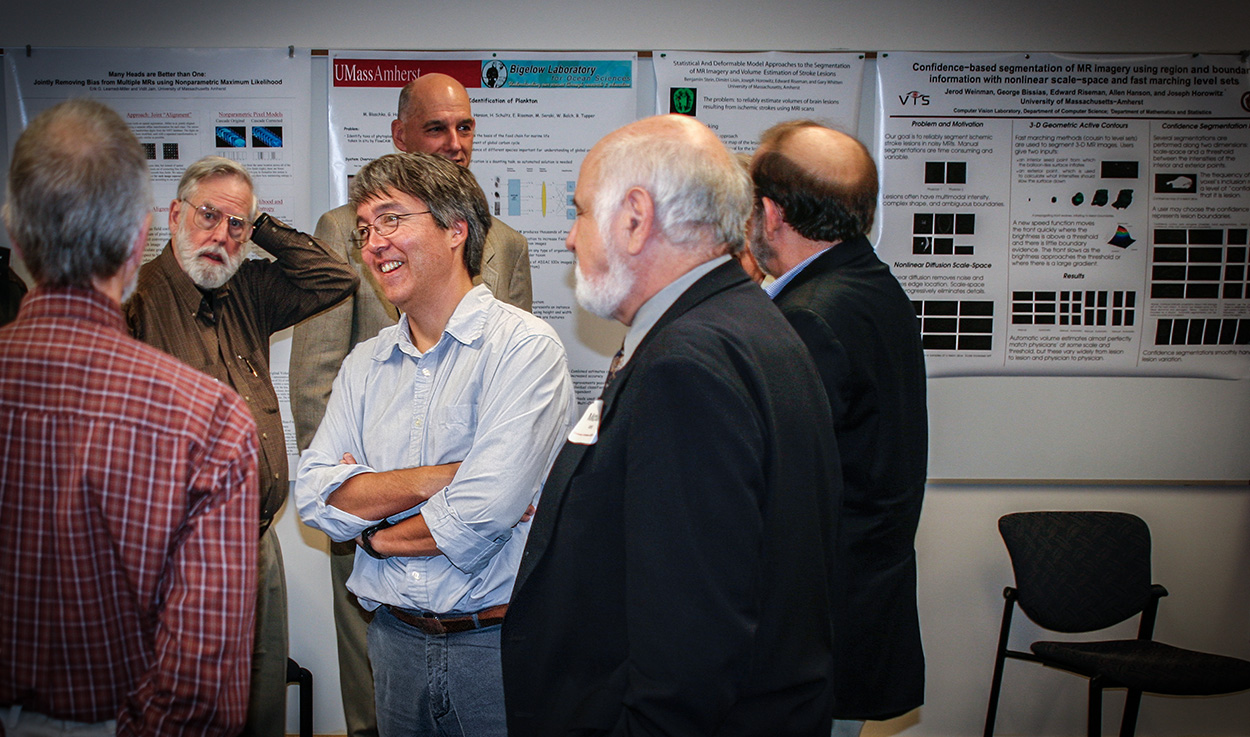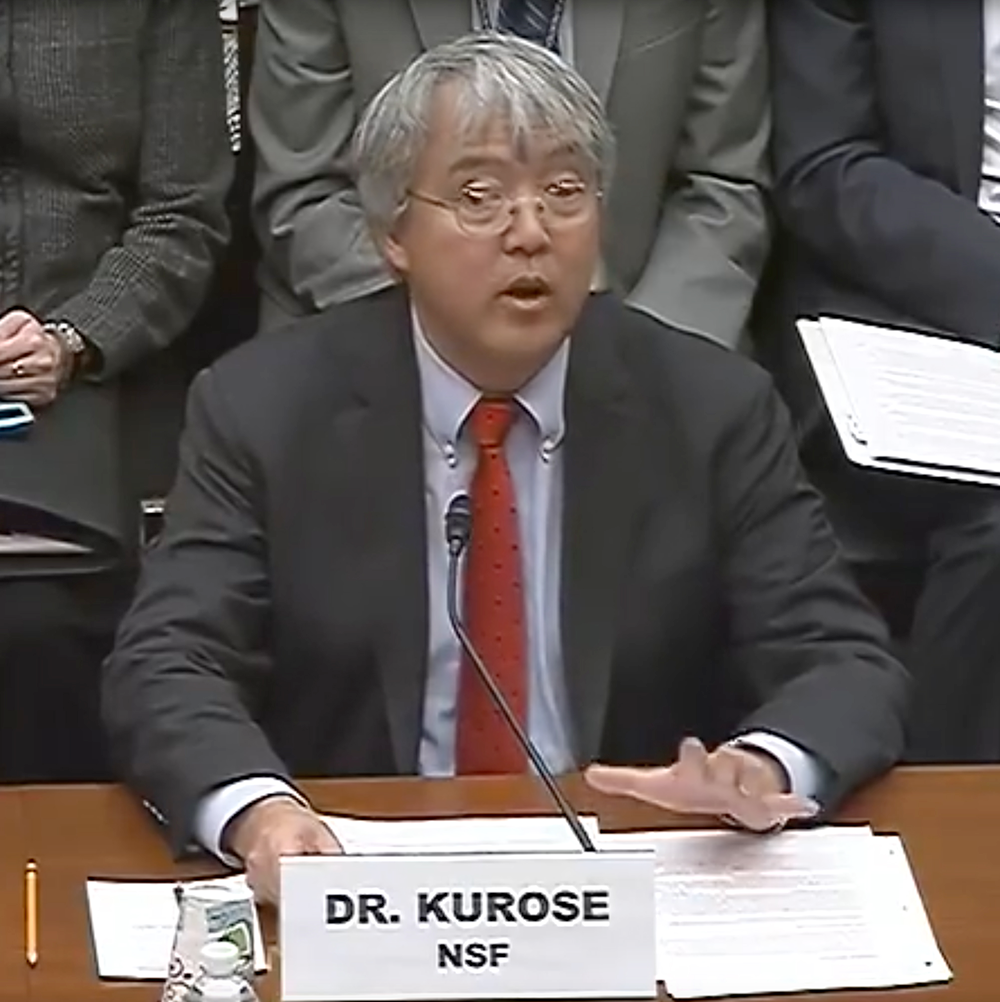Jim Kurose Looks Back – and Foward
 Jim Kurose straightened his notes and sized up the panel of men and women seated on the dais in front of him. The camera lights shone brightly, making it difficult to see the clocks indicating when he was to start talking—and when to stop. After just one month into his position at the National Science Foundation (NSF), Kurose was about to testify before a congressional subcommittee. And although he was ready to brief the subcommittee on cyberthreats, state-of-the-art cryptography, and the value of interagency cooperation, his thoughts drifted elsewhere. “You know that David Byrne line, ‘You may ask yourself, ‘Well, how did I get here?’” he asks. “Yeah, that was very much on my mind.”
Jim Kurose straightened his notes and sized up the panel of men and women seated on the dais in front of him. The camera lights shone brightly, making it difficult to see the clocks indicating when he was to start talking—and when to stop. After just one month into his position at the National Science Foundation (NSF), Kurose was about to testify before a congressional subcommittee. And although he was ready to brief the subcommittee on cyberthreats, state-of-the-art cryptography, and the value of interagency cooperation, his thoughts drifted elsewhere. “You know that David Byrne line, ‘You may ask yourself, ‘Well, how did I get here?’” he asks. “Yeah, that was very much on my mind.”
As Kurose eases into partial retirement and reflects on a 40-year career at the top of his field, he finds many moments of incredulity and gratitude. There were the times spent as a visiting scientist at several of the world’s top institutions: IBM Research, the University of Paris, the French National Institute for Research in Digital Science and Technology (INRIA), and Technicolor Research Labs. There were the years he lived in France, his stints in Washington, DC, adventures at the South Pole (“That was another ‘how did I get here?’ moment,” he says), and working with colleagues in Brazil, India, Australia, Japan, among other countries. But for those who know him well, there is little mystery as to how Kurose found himself in so many high-profile roles. “Jim is warm, caring, and relates well to other people,” says longtime friend and fellow professor emeritus Rick Adrion. “He’s very charming and a great teacher, which allows him to easily connect with various constituencies.” Indeed, although Kurose is known internationally for his research and teaching of network architecture, protocols, and for his artificial intelligence (AI) work in Washington, it is his ability to connect with others and communicate complex concepts that has made him a sought-after expert at home and abroad.
Long before Kurose served as advisor to the world’s most powerful legislative bodies, he honed his teaching and narrative skills in a less intimidating setting—at the front of a UMass Amherst classroom, where he taught as a distinguished professor of computer science for nearly four decades. From the offices at Governors Drive to those at Pennsylvania Avenue, Kurose has developed a sense for where the field of computer science may be headed, and his opinions are worth noting as he looks both forward and back.

There’s an app(lication) for that
For Jim Kurose, there’s a close relationship between computer science theory and systems and the applications they enable. Indeed, since his early years as a professor, he has focused on applications as a launch point for students, meeting learners where they are and building on experience-based inquiry.
To teach the basics of the internet, for example, Kurose begins with a student’s previous knowledge. “Everyone has a web browser, and humans execute all kinds of protocols, so we start there. I’m not going to tell you details about how your message gets from point A to point B along a wire, but I am going to tell you that there’s a protocol called HTTP, and it works by simply asking for something—a web page, for example—and receiving something,” he explains. “From there, we can go deeper in our understanding, but it always helps to start with the applications people know.”
His pedagogical approach of moving from a system’s application down to its physical layer came to define Kurose’s teaching style, culminating in his co-written textbook, Computer Networking: A Top-Down Approach. Now in its eighth edition, Computer Networking sells more copies than all other networking textbooks in the college market combined, according to his publisher.
Over time, Kurose’s reputation as a networking expert and as a talented communicator spread beyond the UMass campus, leading him to opportunities he had never imagined. He has served in leadership roles for top technical conferences, academic journals, and technical societies in computing. In 2015, the NSF invited Kurose to serve as assistant director of the Directorate of Computer and Information Science Engineering, a position he held for the next five years. While at NSF, he also made his mark as assistant director for AI in the White House Office of Science and Technology Policy (OSTP), advising those who advise the president. It was in these capacities that Kurose found himself testifying before Congress as an expert witness, educating lawmakers on trends in cybersecurity, AI, and high-performance and quantum computing. “I haven’t rehearsed anything as many times as I rehearsed [my testimony], right down to the second,” he says.
During his tenure at NSF and OSTP, AI was just beginning to emerge as a field of tremendous social, economic, and workplace impact. With a view to the considerable role AI would play in the years ahead, Kurose and his NSF colleagues stressed the need to pump increased national effort and funding into AI research. Their work on the National AI Research and Development Strategic Plans of 2016 and 2019, along with years of interagency collaboration that began during Kurose’s tenure, culminated in the announcement of the first seven National Artificial Intelligence Research Institutes. There are now 25 such institutes nationally, with areas of specialization in both the foundations and applications of AI. “At NSF, you’re asked to think about what’s important for the country— and for AI, it was important for the country to double down on the amount of funding that was going into research,” says Kurose.
Having served under two presidential administrations and eager to get back to his home in Western Massachusetts, Kurose returned to UMass Amherst in 2019—and in the summer of 2023, after 40 years in education, he announced his partial retirement. Although his departure from full-time teaching won’t bring his work in computer science to a full stop, he acknowledges that it’s a useful opportunity to take note of where the field has been and where the next generation may find opportunities to innovate.
“At NSF, you’re asked to think about what’s important for the country—and for AI, it was important for the country to double down on the amount of funding that was going into research.” - Jim Kurose
Hindsight is 20/20
Jim Kurose keeps an image of the Roman god Janus pinned to the sidebar of his personal blog. Like the dual-faced god of transitions, the retiring professor now enjoys split views of the lessons of the past and the possibilities of tomorrow. What wisdom can he mine from decades of research?
The story of one lesson learned brings him back to his early years as a researcher in the 1980s, when the internet as we now know it was still years away. Kurose was fascinated by the challenge of transmitting video across networks. “When I did my thesis, computer networking was still considered a bit of a backwater area,” he says. “I was interested in multimedia applications like teleconferencing and serving videos on demand, but the network link capacities were such at the time that networking only made sense for file exchange, not really for video.”
To overcome the constraints of these networks, Kurose and his colleagues focused on a next-generation network that would respect the timing constraints of video and clock transmission of video data with guaranteed timing and delivery. “This next-generation architecture was standardized, prototyped, demonstrated … but never really used,” he admits. “We had envisioned a global network that supported video as a class of traffic going through the core and then to their destinations. In practice, though, there are now a lot of video servers deployed very close to customers and so you don’t have to worry too much about timing.”
Among Kurose’s many takeaways from this experience is that practical often wins out over optimal—just ask Netflix. “Our original thinking was that the network would provide timing and delivery guarantees, but it turned out that so long as you have enough transmission capacity, the best effort model of ‘well, we’ll try,’ turned out to be good enough, when combined with clever application-level adaptation. Our research group was also one of the first to look at multimedia application-level adaptation to network impairments, both theoretically and experimentally,” says Kurose, adding, “You have to hedge your bets, because you never know how things will work out.”
Keeping it real
During his time at NSF, AI emerged as a technology requiring lawmakers’ attention. Kurose and his colleagues began advocating for government policy to put guardrails around future AI development. The United States was not the only country concerned about AI, and in 2018, Kurose became one of three U.S. government representatives invited to advise the Organization for Economic Cooperation and Development (OECD), an international consortium of liberal democracies, on a set of AI guidelines. This group produced a landmark set of AI principles in 2019, which were adopted by all member OECD countries. The effort marked the first time an international group had assembled to discuss a system of safeguards around AI at this level, a concern that has more recently come to the forefront in government policy around the world.
Although AI is not Kurose’s area of research, his hands-on work at the NSF and OECD granted him a prescient view of the pitfalls ahead. “The role that misinformation or disinformation in data plays in outputs from AI systems is very difficult to solve,” says Kurose. “The core of the issue is, what is truth? Sure, you’ve got data, but where did it come from?” He stresses that the challenge in curating reliable information for AI algorithms is as philosophical as it is technical, and requires a diverse team to address it. “Computer scientists are certainly responsible for thinking about the benefits and risks of the technologies we invent, but we also need people from the social sciences and civil society to think about how these technologies should be used,” he says. Kurose notes that he was particularly pleased that the UMass College of Information and Computer Sciences has adopted a policy of “computing for the common good,” and that new programs such as the campuswide effort in public interest technology are thriving. “In the end, a lot of modern computing is about people,” says Kurose.
Like many in the field of AI, Kurose advocates for transparency in both the building of systems and the curation of data used as inputs. “These systems should be auditable,” he argues. “Companies need to show what decisions were made and how they were made—and that goes for the full life cycle of the system.” His assertion is reflected in the OECD principles he helped inform, which call for a disclosure of a system’s means of operations, including “the logic that served as the basis for the prediction, recommendation, or decision.”
People Power
When asked what he treasures most about his career at UMass, Kurose doesn’t hesitate. “People!” he replies. “I’ve had fabulous students in research [Kurose has graduated 30 PhD students, many co-advised with his colleague Don Towsley] and amazingly talented and engaged colleagues.” Besides his passion for research and teaching, for which he has received numerous honors, including being elected a fellow of numerous technical societies and a member of the National Academy of Engineering, Kurose is clearly a “people person” who enjoys working on computing initiatives at both the state and national level. And although Kurose’s work has garnered countless awards, his colleague Rick Adrion stresses he is always guided by humility. “His reputation has made him very visible, but he’s used that—not to benefit himself—but to benefit the college,” says Adrion.
 In addition to Kurose’s national work at NSF and OSTP, he has helped lead state-level initiatives such as the Commonwealth Information Technology Initiative, which helped modernize and broaden computing across all of sectors of Massachusetts public higher education, and the Massachusetts Green High Performance Computing Center in Holyoke, where he serves as board chair. “I’ve clearly got that ‘service gene,’” Kurose notes, adding, “It’s important to support and contribute to efforts and institutions that really move the needle for people working in computing.”
In addition to Kurose’s national work at NSF and OSTP, he has helped lead state-level initiatives such as the Commonwealth Information Technology Initiative, which helped modernize and broaden computing across all of sectors of Massachusetts public higher education, and the Massachusetts Green High Performance Computing Center in Holyoke, where he serves as board chair. “I’ve clearly got that ‘service gene,’” Kurose notes, adding, “It’s important to support and contribute to efforts and institutions that really move the needle for people working in computing.”
Adrion worked alongside Kurose on Holyoke’s computing center, and remembers his colleague as a like-minded partner. “Jim and I share that ‘service gene,’ and we wanted to make sure that Holyoke benefited,” recalls Adrion. “But as a credit to Jim, he was the one who worked with many of the city’s community-based organizations, making sure that they stayed connected to the center and saw a benefit.”
Despite announcing his partial retirement, Kurose is not ready for a life of beaches and piña coladas. “I love to teach and I love to write, and I’m not giving up either,” he says, noting that he will continue to teach part time, is at work on his textbook’s ninth edition, and is developing a new course on wireless and mobile networking. But he does allow himself the occasional retrospective moment. “I came to UMass right out of graduate school, and it’s been an absolutely wonderful place to grow and nurture a career,” he says. “I’m proud of the things I’ve accomplished so far, but it was because I was in a place that allowed me to do them. Great colleagues, amazing students …” Here Kurose trails off, smiling in a moment of reflection. One imagines Janus turning to face the future, the light of opportunity constant and bright.
Celebrate the career and accomplishments of Jim Kurose, April 5-6, 2024.
This story originally appeared in the Winter 2024 issue of Significant Bits Magazine.